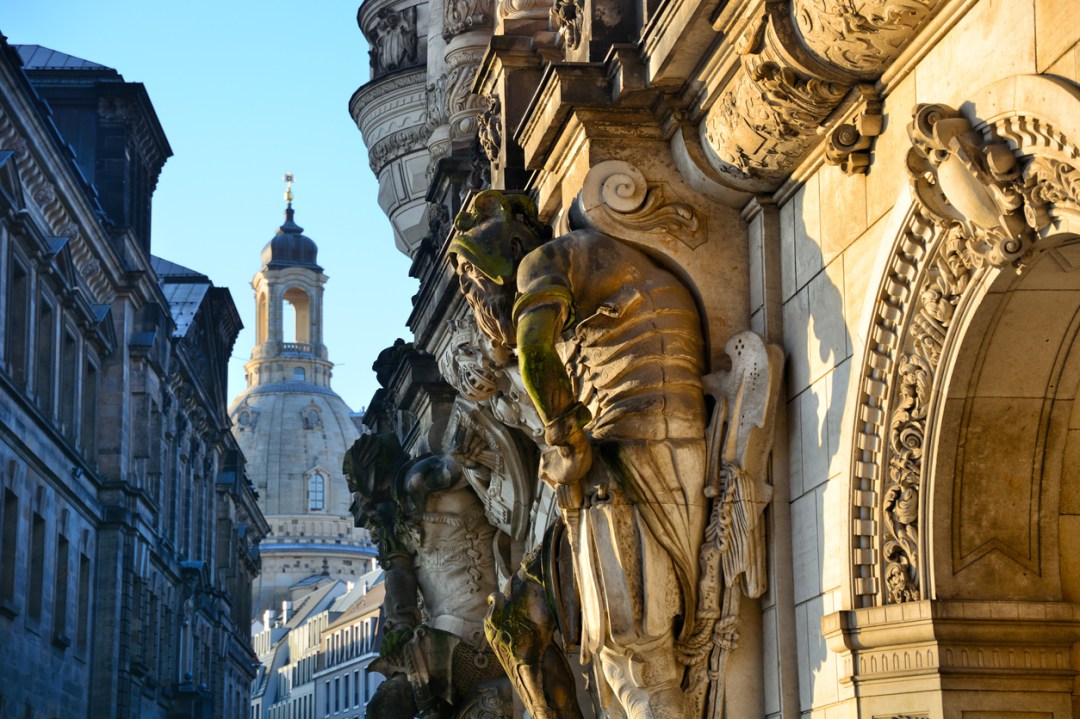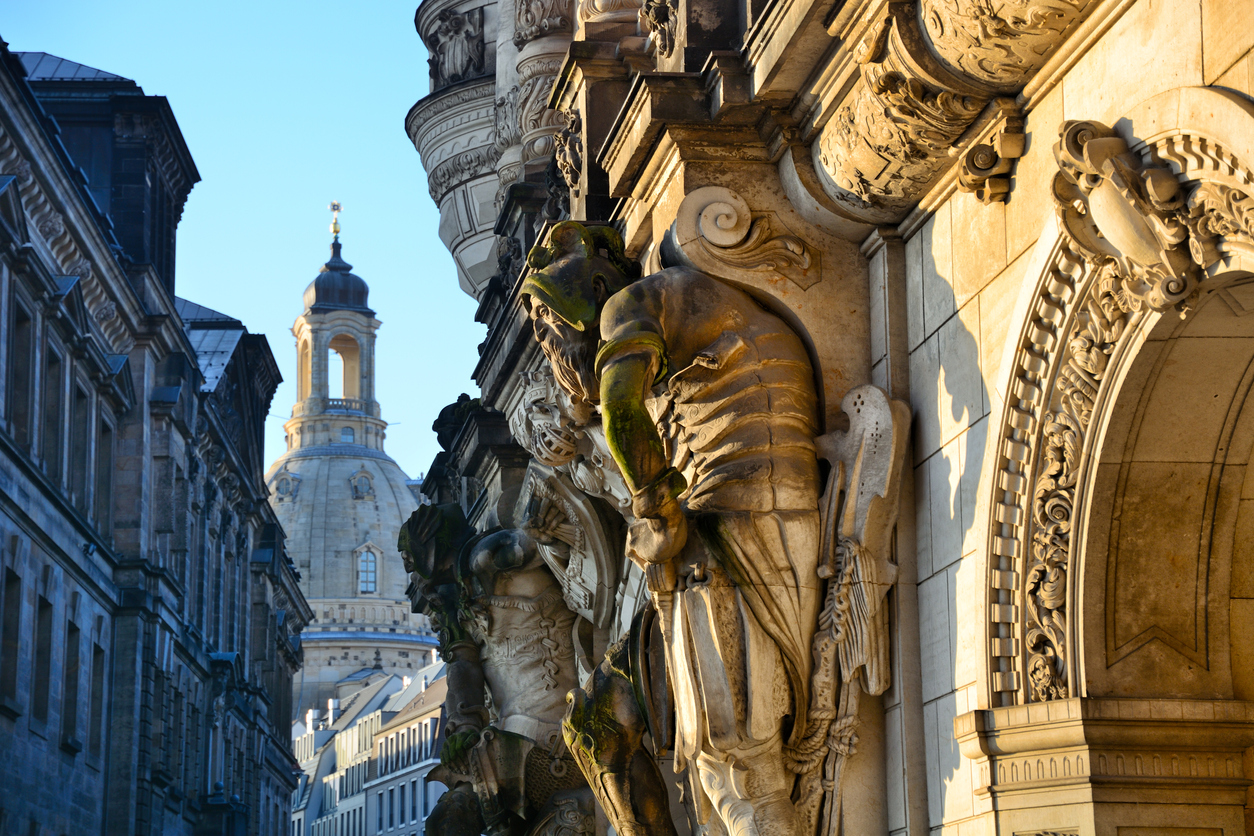Strolling along Dresden’s Brühlsche Terrasse, an elegant promenade above the River Elbe known as ‘the balcony of Europe’, the wartime destruction of Germany’s most beautiful city seems like the echo of a bygone age. Since reunification, the reconstruction of its baroque Altstadt has been meticulous – the panorama Canaletto painted has been painstakingly restored. Reduced to ruins in February 1945, Dresden can once more be called ‘the Florence on the Elbe.’
Much ink has been spilt over the rights or wrongs of the Allied bombardment of my father’s birthplace (he was born here in 1942 and survived the bombing as a small boy), obscuring the far more interesting story of what made Dresden so attractive in the first place. The reason the Saxon capital is so beautiful is largely due to a decidedly unenlightened despot called August der Starke (Augustus the Strong) and as you stroll along the Brühlsche Terrasse the roots of his finest legacy – the creation of European porcelain – lie right beneath your feet.
August’s aesthetic tastes were progressive, but his management style was medieval
When August der Starke was born, in 1670, Dresden was a relative backwater, and it might have remained so if his elder brother, the Protestant Elector of Saxony, hadn’t died of smallpox in 1694. Augustus (the spare rather than the heir) had never expected to rule over Saxony, so he’d spent his pampered youth galivanting around Italy, Spain and France, where he acquired a taste for the finer things in life, and a Catholic, rococo sensibility. He met Louis XIV and was much impressed by the bombastic grandeur of Versailles. In 1697, he converted to Catholicism in order to win the crown of Poland and subsequently set about transforming Dresden into a city fit for a Teutonic Sun King.
Dresden became a boom town, full of grandiose new buildings – and like all boom towns, then and now, it attracted all sorts of adventurers, eager for a slice of the action. One of these chancers was a young chemist from Berlin called Johann Friedrich Böttger, who claimed to know the magical solution to the quest of alchemists throughout the ages – how to turn base metal into gold.
Böttger probably thought he could wangle a nice fat hand-out from August, a man who was lavishing money on all sorts of vanity projects (Pillnitz and Moritzburg castles are among the many flamboyant follies that have survived).
However, König August wasn’t nicknamed August the Strong for nothing. Reputedly weaned on lion’s milk, he’d sired several hundred bastard offspring. His favourite party trick was bending horseshoes with his bare hands. His aesthetic tastes were progressive, but his management style was medieval. Rather than giving Böttger a generous research grant and leaving him to his own devices, August imprisoned him in Dresden’s catacombs, and told him he’d only be released when he made good his promise.
Was August familiar with the German fairytale of Rumpelstiltskin, about the miller who brags that his daughter can weave straw into gold, and the king who imprisons her until she does so? Did he believe Böttger’s rash boast? Or was incarcerating him merely a particularly malevolent practical joke?
Naturally, Böttger’s proposition turned out to be total BS, and so for several years he languished in Dresden’s catacombs, tinkering away to no avail. He might have remained there forever if August hadn’t recruited another German chemist called Ehrenfried von Tschirnhaus, and commanded the two of them to work together on this futile scheme.
Von Tschirnhaus was equally incapable of turning base metal into gold, but he was a lot smarter than Böttger – an eminent mathematician and scientist, rather than an alchemist of dubious repute – and in 1707 he came up with something almost as valuable: a formula for creating fine porcelain, aka ‘white gold.’
For centuries, ever since the first porcelain arrived in Europe from China, Europeans had been trying to find a way of making fine porcelain of their own. Chinese porcelain was much coveted – European pottery was crude and heavy by comparison. Finding out how to make it was a tremendous breakthrough, giving Saxony an enormous advantage over every other European state.
August was delighted. He commissioned von Tschirnhaus to draw up plans for a new factory, devoted to the manufacture of Saxon porcelain. Since the process must remain top secret, a secure and relatively secluded location was selected – Albrechtsburg, a castle in Meissen, a hilltop town on the River Elbe.
By finding the formula for fine porcelain, von Tschirnhaus secured Böttger’s freedom. In 1708, he did Böttger an even bigger favour by conveniently dropping dead. As the only other person with a working knowledge of this new process, Böttger was the natural choice to head up this new factory instead.
August’s pioneering factory opened in Albrechtsburg in 1710, and though Böttger died in 1719, the factory remained in the same location, churning out Meissen china, until 1863, when it moved down the hill to Triebischtal, a nearby suburb where it remains today. Over 300 years on, the term Meissen remains synonymous with top-quality, highly collectable porcelain.
You can visit the factory and watch the craftsmen (and craftswomen) at work, and buy crockery and figurines, but the biggest treat is hunting for imperfect seconds in the old curiosity shops around Meissen, a medieval citadel which came through the second world war virtually unscathed.
August died in Warsaw in 1733, and was buried in Krakow, but his heart was brought back to Dresden and laid to rest in his Catholic cathedral, the Hofkirche. You can see the Hofkirche under construction, still under scaffolding, in a Canaletto painting in August’s Zwinger palatial complex.
The Zwinger also contains August’s priceless stash of porcelain: 2,000 pieces on show, out of a collection of 20,000. As well as an unrivalled display of Meissen, there are some precious Oriental pieces, most notably the Dragoon Vases, which August obtained from Friedrich Wilhelm I of Prussia in exchange for an entire regiment of dragoons. Mercifully, his hoard survived the Allied bombing, the Russian invasion, and 40 years behind the Iron Curtain. Now it’s open to the world again.
The first time I went to Dresden, in 1995, the only other foreigners on my internal flight were an intrepid Japanese couple. They spoke no German and scarcely any English, but they weren’t deterred. They’d come to see the porcelain. I saw them at the Zwinger. Next day, in Meissen, I bumped into them once more.
Back then August’s finest church, the Frauenkirche, was a pile of rubble – left there as a memorial by German communists after the war. When I returned to Dresden, a few years later, German capitalists were rebuilding it. Now it’s complete, a jumble of original and modern masonry, a mottled mix of old and new. Up close it’s spectacular, towering over the replica buildings that surround it. From a distance it looks like a patched-up Meissen ornament, shattered into a hundred pieces and patiently stuck back together.
My grandmother caught the last train out of Dresden before the Red Army arrived, taking my father back to her hometown, Hamburg. They’d been staying with my great aunt, whose husband was in the Luftwaffe (until 1945, Dresden was, quite rightly, regarded as the safest city in the Reich).
The house was by the airfield (a Soviet airbase during the Cold War) so it should have been a prime target, but the RAF and USAAF decided to bomb the historic city centre rather than the strategic targets on the outskirts, and so my relatives survived. Whenever I return to Dresden and wander round its rebuilt Altstadt, I’m struck that I must be one of the few living beneficiaries of that decision.







Comments